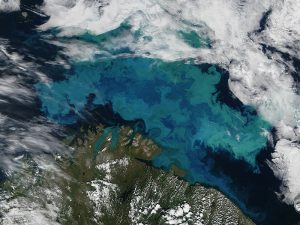Plankton bloom
Physical conditions and nutrient levels can lead to high abundances of particular plankton types. These plankton “blooms” are common throughout the world’s oceans and can be composed of phytoplankton, zooplankton, or gelatinous zooplankton, depending on the environmental conditions.
Phytoplankton population explosion-blooms occur when sunlight and nutrients are particularly available to the plants, and they grow and reproduce to a point where they are so dense that their presence changes the color of the water in which they live.
Blooms can be quick events that begin and end within a few days or they may last several weeks. They can occur on a relatively small scale or cover hundreds of square kilometers of the ocean’s surface.
Photo: bloom in Barents Sea (source: NASA)



 This project (EDU-ARCTIC) has received funding from the European Union’s Horizon 2020 research and innovation programme under grant agreement No 710240. The content of the website is the sole responsibility of the Consortium and it does not represent the opinion of the European Commission, and the Commission is not responsible for any use that might be made of information contained.
This project (EDU-ARCTIC) has received funding from the European Union’s Horizon 2020 research and innovation programme under grant agreement No 710240. The content of the website is the sole responsibility of the Consortium and it does not represent the opinion of the European Commission, and the Commission is not responsible for any use that might be made of information contained.